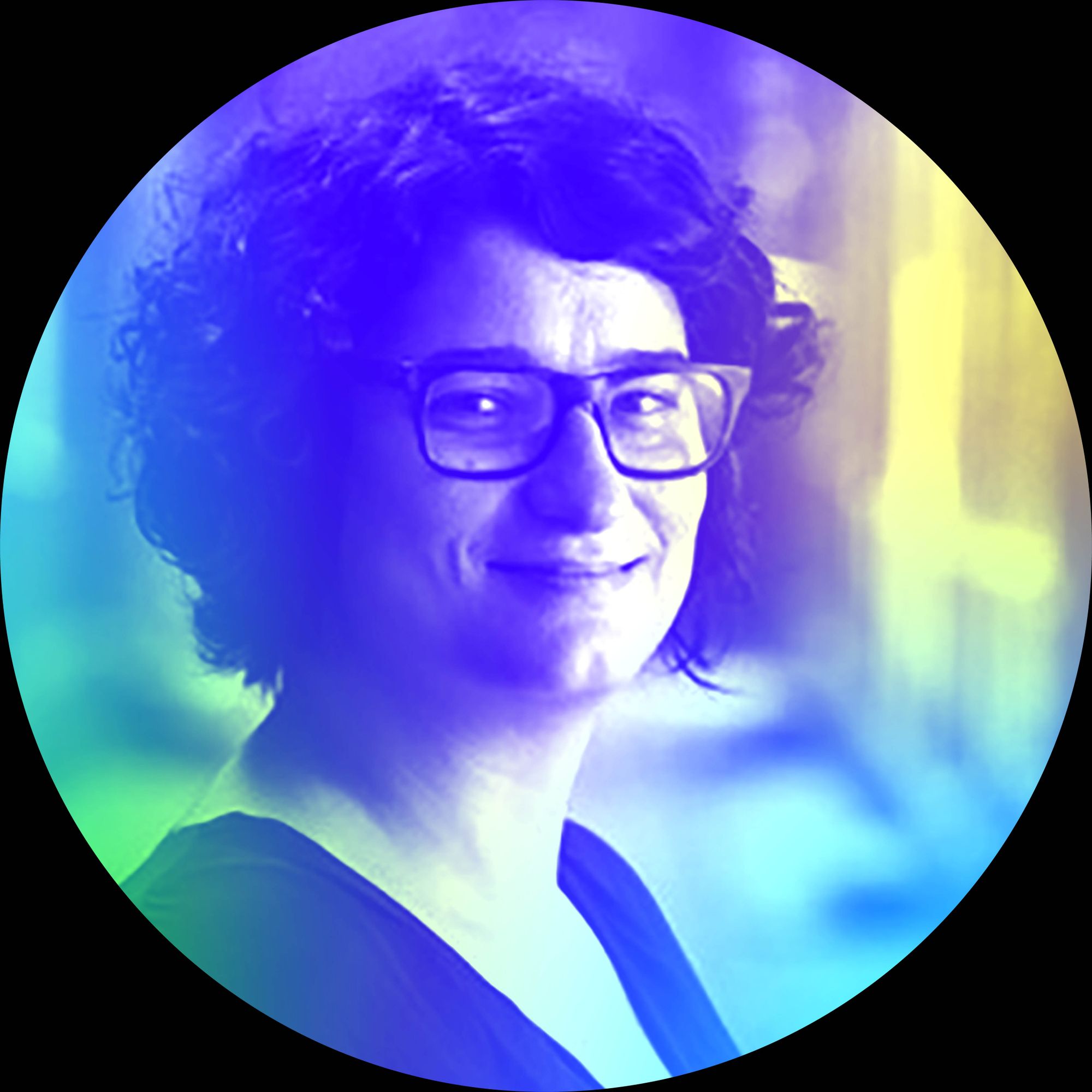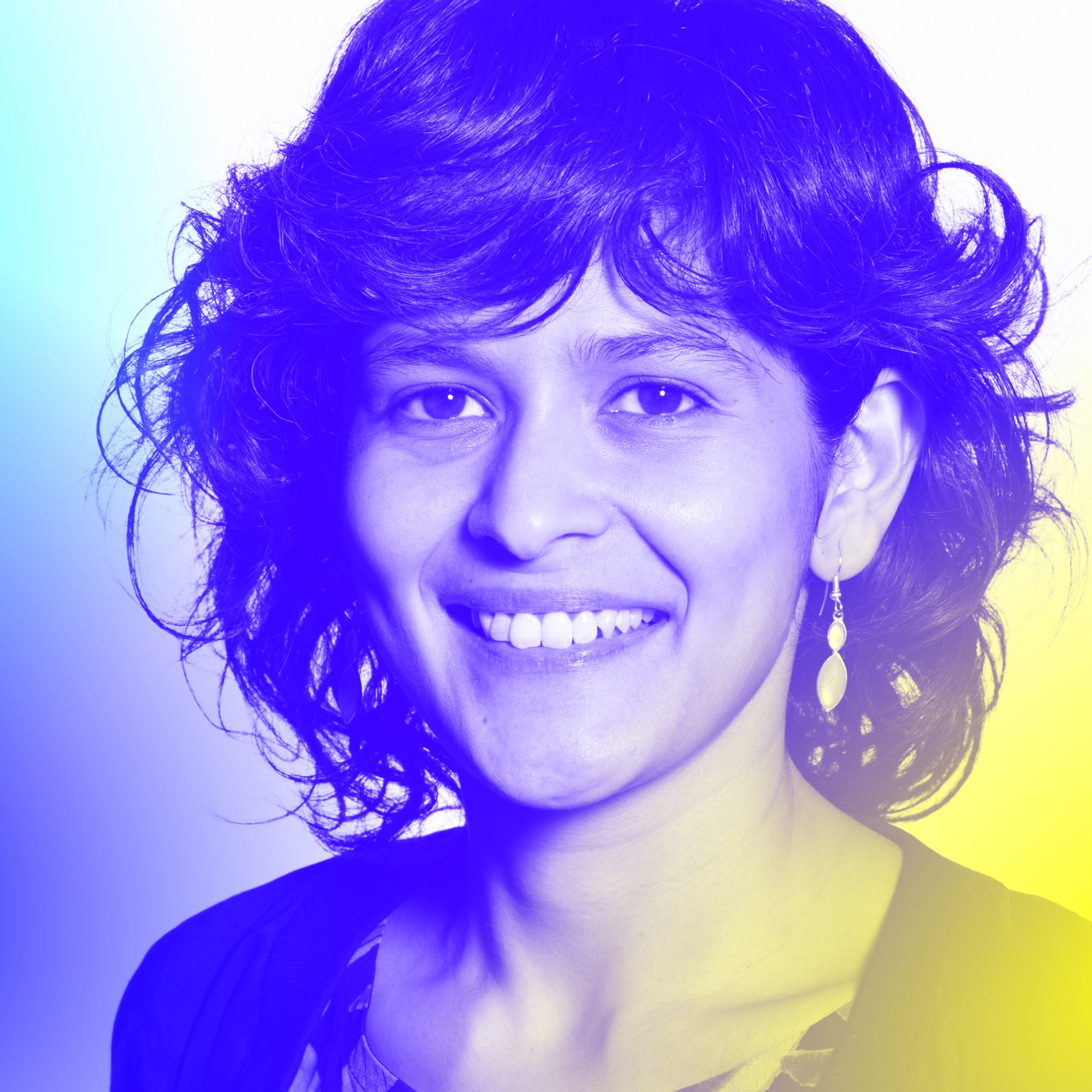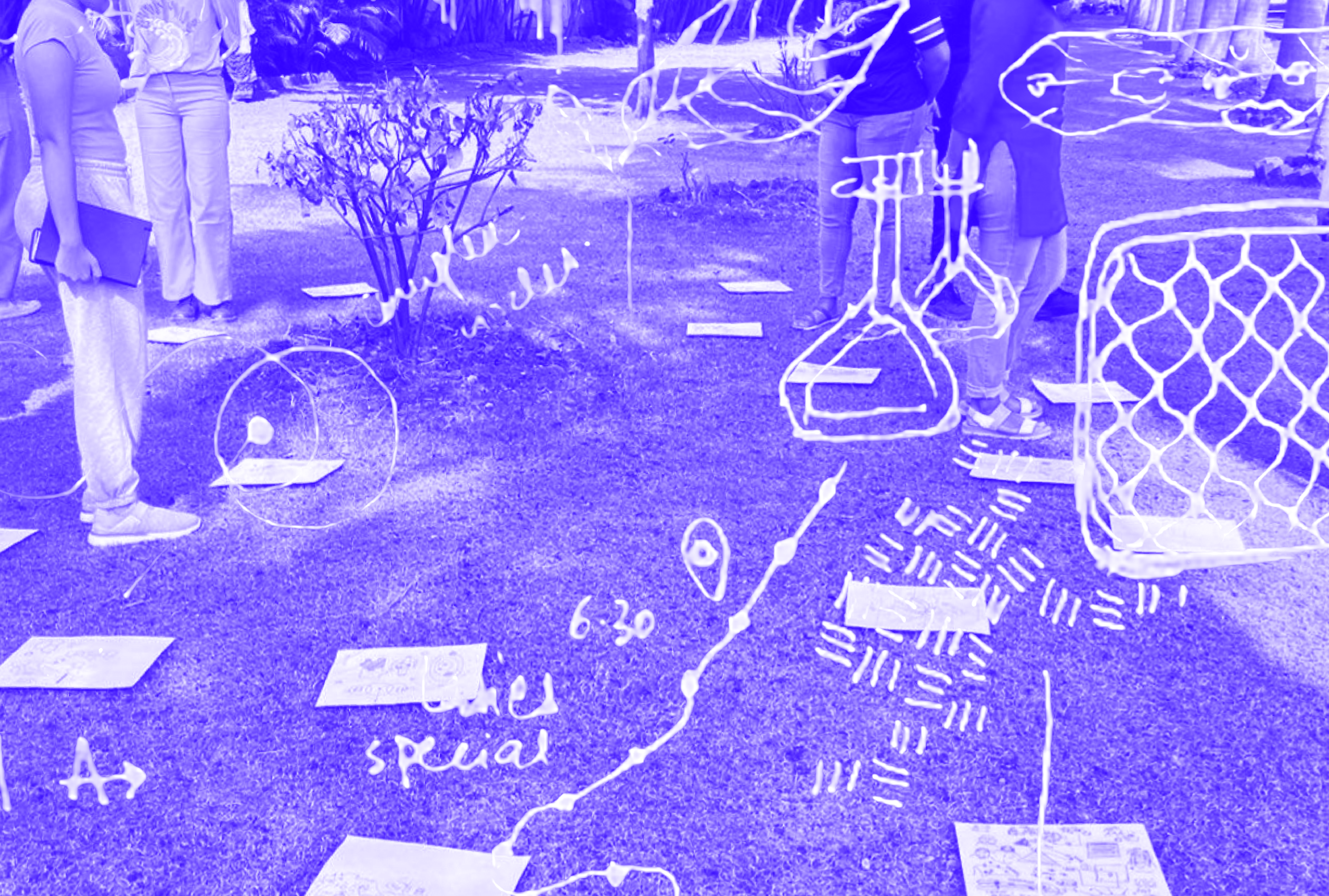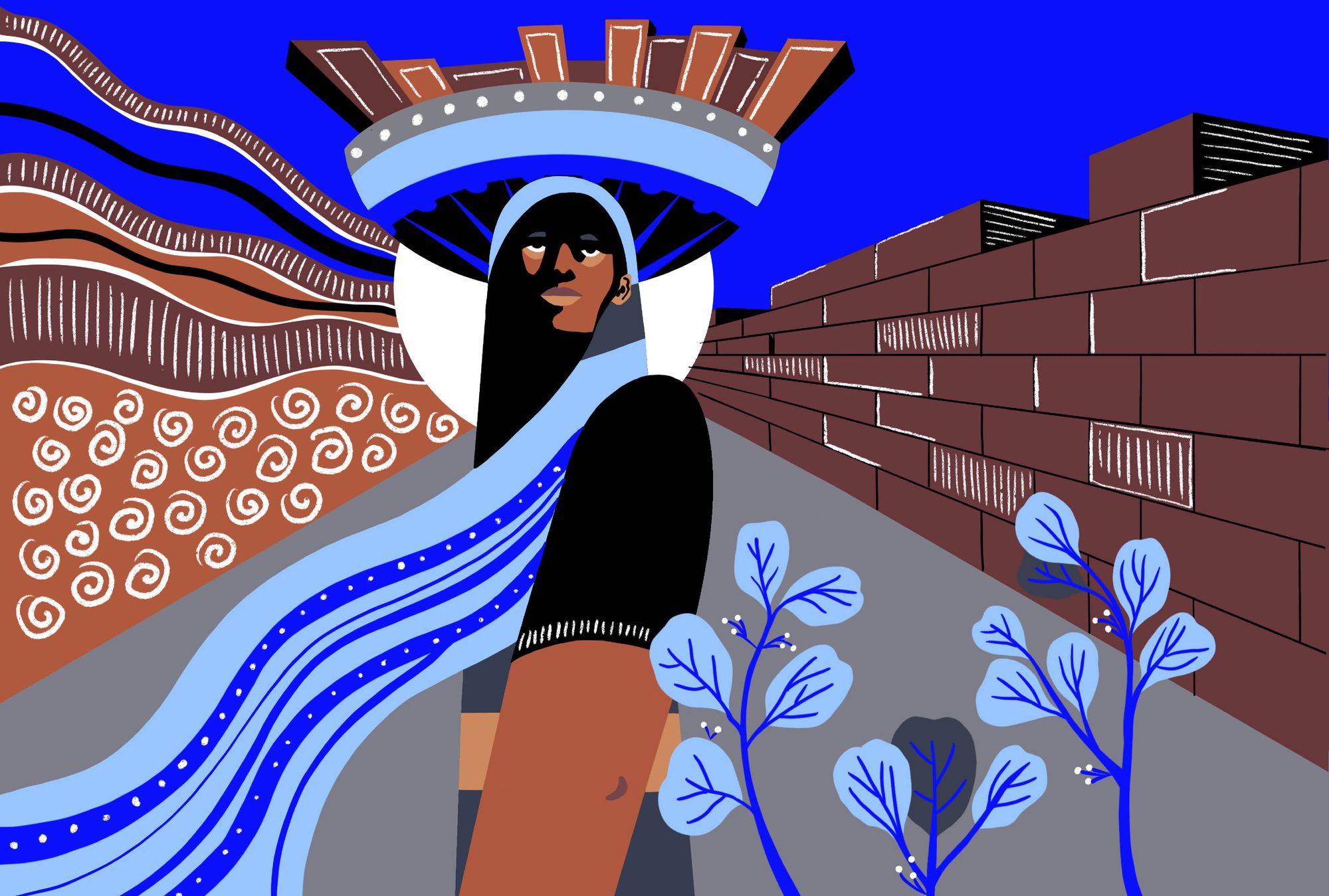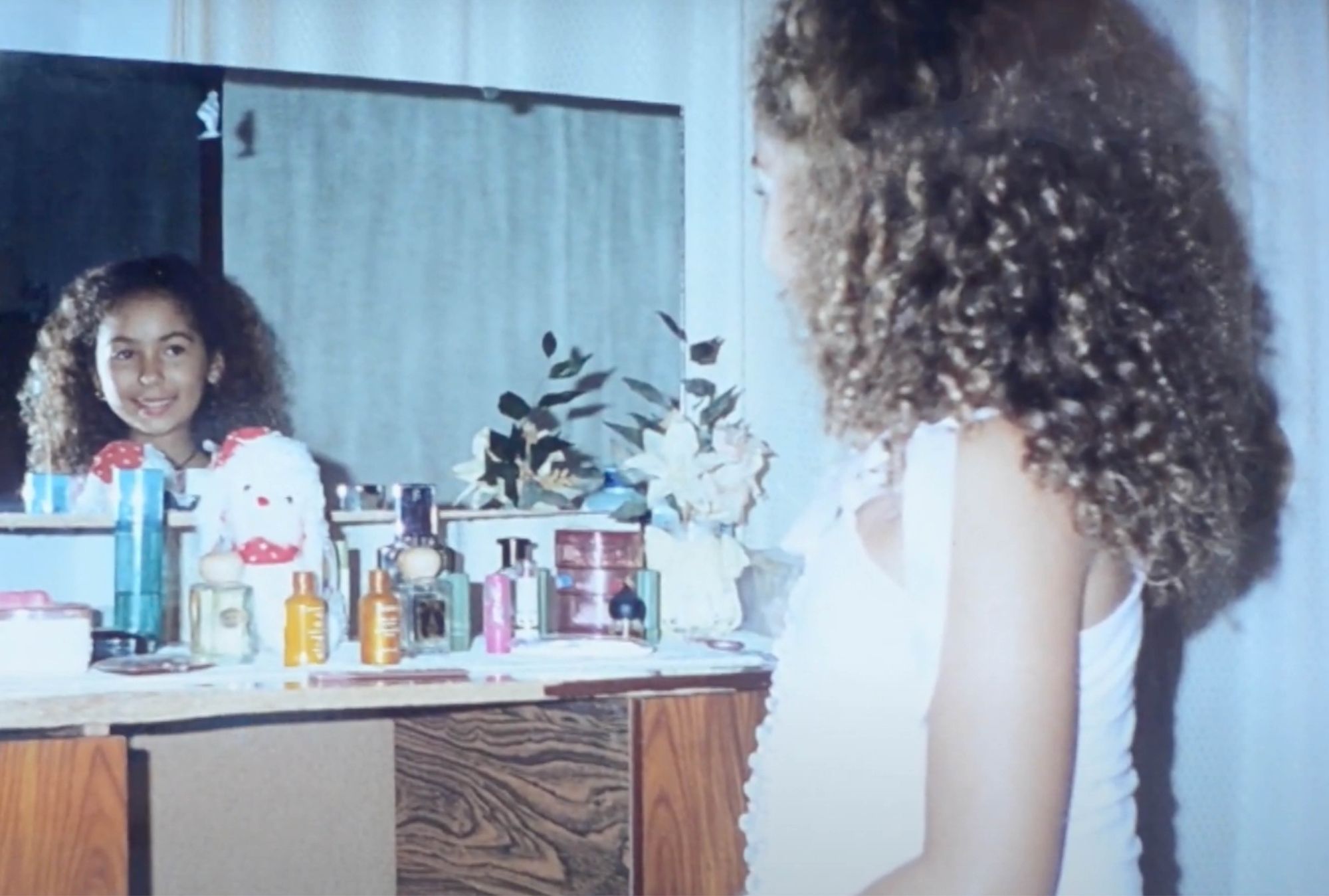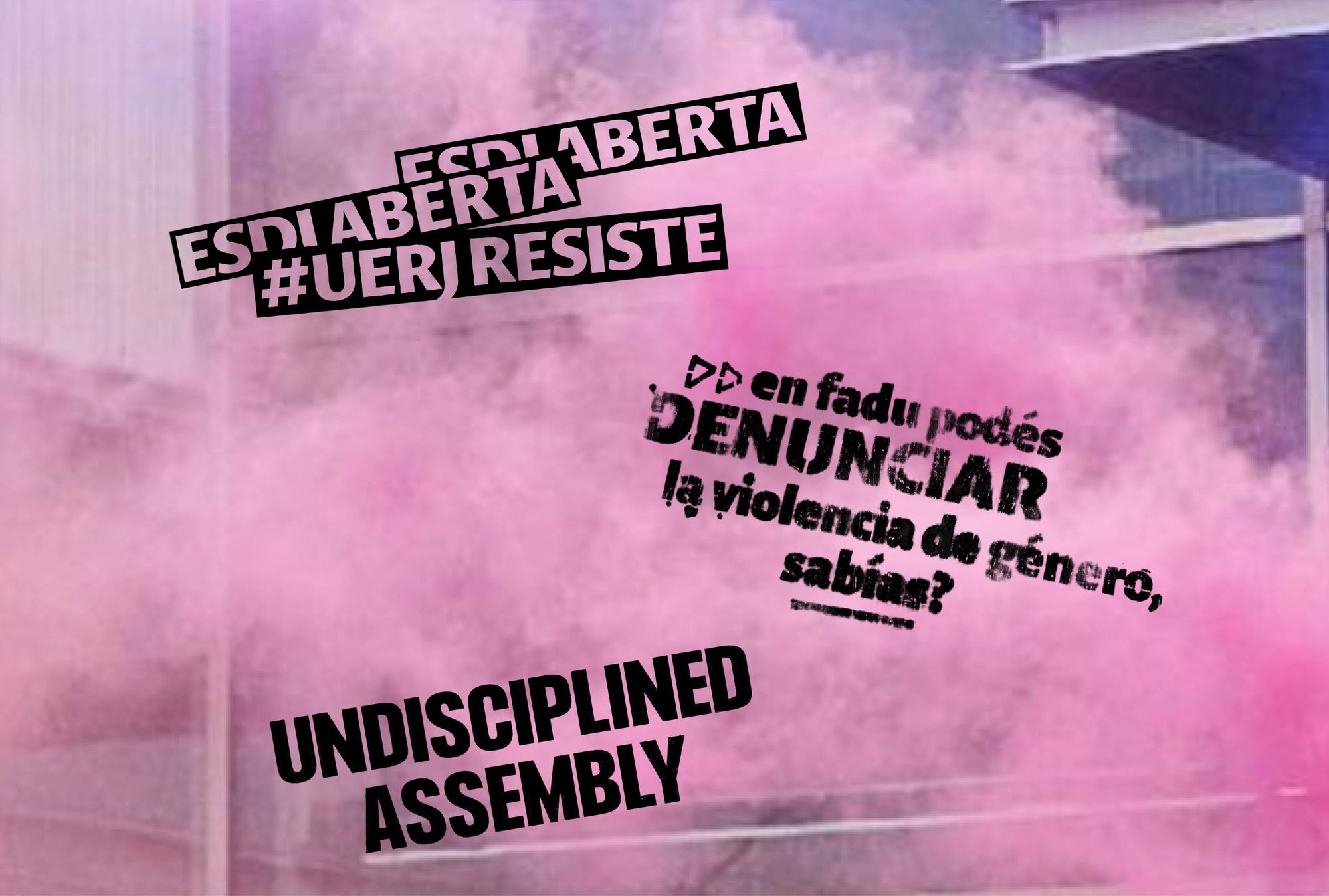
What discriminatory structures lay hidden in design schools accross the globe? What harms do they cause, and how could they possibly be dismantled?
These some of the main questions propelling the following discussion, led by art historian and environmental humanities scholar Sria Chatterjee and organized by the Camden Art Center in July 2021. Chatterjee was joined by three educators addressesing these very issues in different social and political contexts across the globe: Griselda Flesler, professor in Design and Gender Studies at FADU, University of Buenos Aires; Tanveer Ahmed, a senior lecturer in Fashion and Race at Central Saint Martins in London, and Zoy Anastassakis, co-head of the Laboratory of Design and Anthropology at ESDI/UERJ, Rio de Janeiro. Questioning privileges inside and outside the classroom, they grapple with how concepts such as anti-racism, decolonization, and feminism translate into teaching and learning. A main red thred throughout the text is: How to build movements within and outside institutions, working beyond individualized grievances and feel-good gestures, towards tangible collective action?
The text was transcribed and edited for clarity and brevity.
Sria Chatterjee: The Black Lives Matter (BLM) movement brought the struggles of various oppressed groups into sharp focus. A lot of universities, museums, and individual departments have publicly announced their commitments to anti-racist teaching and research. At the same time, it has also led to a neo-liberal appropriation of such struggles, which doesn’t necessarily benefit the people to whom decolonization is ostensibly addressed. In fact, at times, it becomes a shallow, somewhat corporate gloss on positionality, which does nothing to address material conditions or systemic problems. What are your thoughts?
Tanveer Ahmed: Many of my colleagues in the design field and I felt that the BLM had a huge impact in the UK. After the murder of George Floyd, several student-led and staff-led campaigns about inequality and discrimination in design institutions emerged. In my capacity as the Equalities Representatives for the UCU Lecturers’ Union at the Royal College of Art (RCA), we collected testimonies of staff who had faced racism and put them up on our Instagram page. The goal was to put pressure on the RCA and other schools to acknowledge the racial disparity among the teaching staff, recognizing the dominant whiteness. Also, we were demanding change on an institutional level—showing the connection between employment and racism. We can change the curricula and the reading lists; however, if there are no Black and Brown staff members teaching, you don’t see yourself represented as a person of color. It is disempowering.
I was that student, back in 1995—when I graduated from Glasgow School of Art, I was the only Brown student in design in the whole college that year. The only one. And the only time I was taught by a POC teacher was during my second MA in Art and Design in Education at The Institute of Education, University of London, and it was only a one-hour-long evening lecture. As an undergraduate student I had heard racist comments, and I faced them in my professional capacity as well. I don’t think the changes that I’m seeing in the UK design pedagogy would have happened if it weren’t for the Black Lives Matter movement.

Zoy Anastassakis: The breaking point in Brazil was the introduction of affirmative policies from 2000 onwards that welcomed Black (Negros), Brown (Pardos), Indigenous, and working-class students. Currently, 40% of our undergraduate students at ESDI (Escola Superior de Desenho Industrial UERJ, State University of Rio de Janeiro) come from those social and racial quotas. It changed the school tremendously. As a student, back in the 1990s, I had no Black colleagues, my whole class was white. Now it is entirely different, and also the matters of interest have changed. There is a whole wave of people dealing with the racial and gender issues embedded in design in their final projects (BA), dissertations (MA), and theses (PhD). They are changing the way the school is developing.
In 2016, at the Laboratório de Design e Antropologia (LaDA), we started an outreach project, bringing Indigenous artists and researchers to lecture and give workshops at ESDI. We believe that the way to bring institutional change is to encourage these bottom-up movements. There was a powerful meeting between the Black and Brown students and Indigenous artists and researchers. They discussed racism and the political and social implications of being a Black, Brown or Indigenous student at a design school. Those encounters on the ground, in the classroom, put something in motion to bring the needed tension, saying to the institution: you need to change!
“What we understand as liberal appropriation is often the only way of accessing particular politics that some people might have.”—Griselda Flesler
Griselda Flesler: The climax for the Argentinian context was the #NiUnaMenos movement against gender-based violence, which exploded in 2016, particularly the massive awareness of feminism mainly among students and young girls. This translates into mass culture, which later on becomes uncomfortable and underestimated for some progressive positions. So, I ask—going back to Sria’s question—from which position do we assume that something is shallow? What we understand as liberal appropriation is often the only way of accessing particular politics that some people might have. As the Argentinean philosopher Florencia Angilletta explains, “we can’t think about feminism without market.” It is a phenomenon of double circulation that is embedded in the demands of capitalism, but at the same time it uses its dynamics to enhance the impact of these movements on increasingly heterogeneous audiences.
Sria Chatterjee: Speaking about questions of labor and representation, we can also see significant cuts affecting the arts and humanities. The job market has been historically difficult for people from underprivileged backgrounds, either fresh graduates or faculty members. So when you imagine building something new and radically inclusive, how do you do that when so much labor is performed by precarious faculty? How do you really include people—not just invite them for a day or two, but have people there who can achieve the change partly bottom-up and kind of from the middle?
Tanveer Ahmed: I’ve been in a precarious employment position for most of my career in fashion design education. Many POC educators feel that we don’t get permanent posts or have the career progression of our white colleagues. That’s why I wanted to be a representative for the Lecturers’ Union at the Royal College of Art: I could see the link between casualization and being a woman of color. Why don’t most of my colleagues of color, particularly females, get senior posts? What’s happening here? There is plenty of research pointing to the recruitment pitfalls, such as systemic racism, which starts with the interview process. During the interview process as a student, I didn’t get into my first choice undergraduate course. I know that this has been really common among people of color. Luckily, some institutions in the UK are beginning to set out anti-racist agendas, such as UAL (University of the Arts London) which aims to have one third of its staff from a Black or Brown background within the next three years.
“We often get so absorbed in discussions about the design projects, that we forget to question who can even get through the front door of the university.”—Tanveer Ahmed
When it comes to the students, here in the UK where we have some of the highest tuition fees in the world, access has become a hugely contested topic. We often get so absorbed in discussions about the design projects, that we forget to question who can even get through the front door of the university. At the Royal College of Art, the Lecturers’ Union, alongside the Students’ Union, has been working to create a number of scholarships exclusively for Black students, with an aim to have every course at the college represented with at least one sponsored Black student, to recognize the role of anti-Blackness and how that particular group are affected in ways that other marginalized groups are not.
Sria Chatterjee: Design is a versatile field. While often considered an arts and humanities subject, it has wide-ranging applicability in fields such as engineering, artificial intelligence, and so on. So, what is design doing and what can design do in the face of the different kinds of precarity we face—not just in terms of the job market, but also from an environmental sustainability perspective, and in particular in places that are politically precarious as well? What kind of futures do we want for our students?
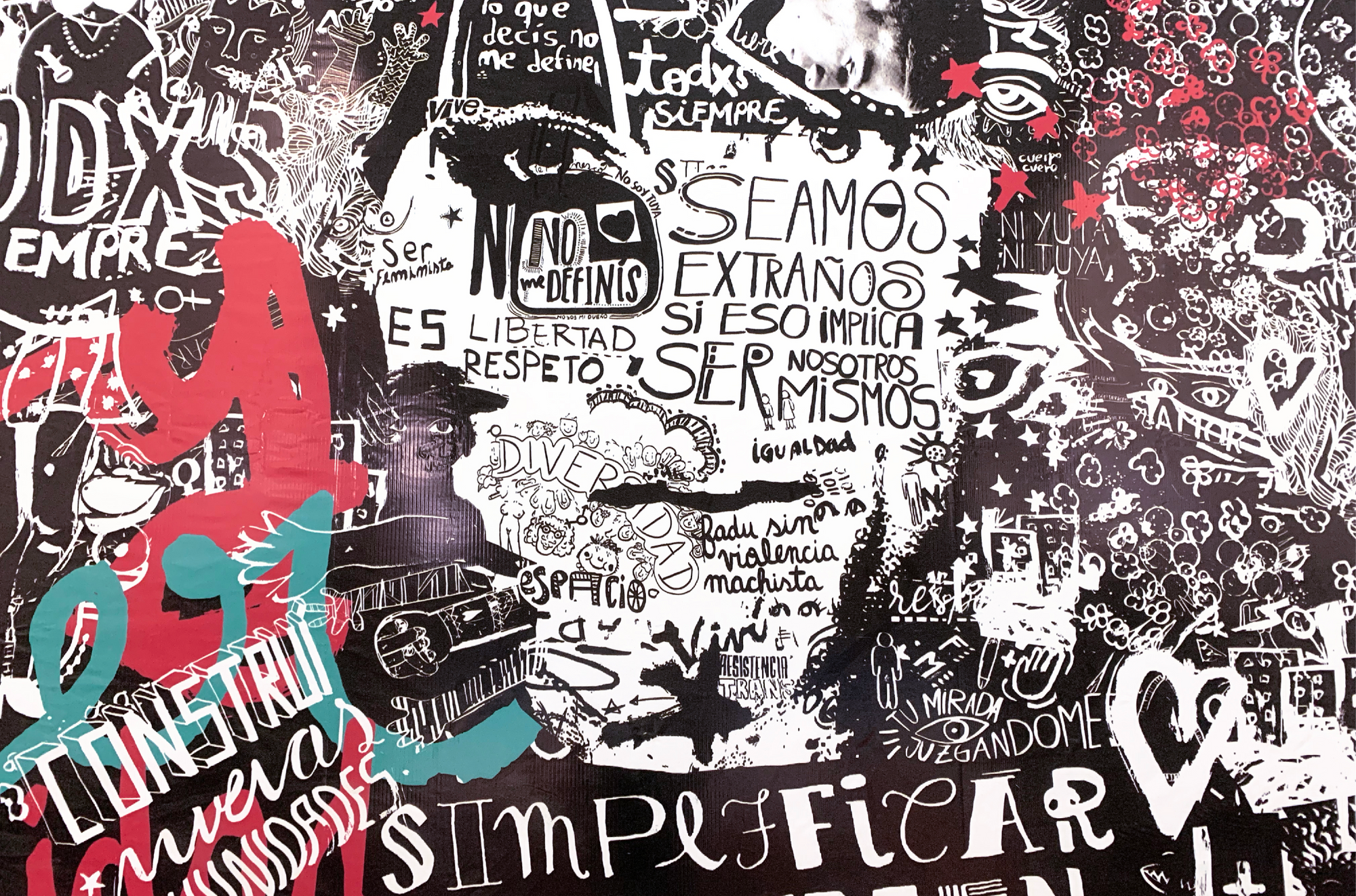
Griselda Flesler: I teach at the Faculty of Architecture Design and Urbanism at the University of Buenos Aires FADU-UBA, the biggest faculty of design at a free, public university in South America, with around 25,000 students. It is autonomous and self-governed by students, lecturers, and graduates who all sit in the government, including unions of non-academic workers and teachers. Within this context, there is a deep commitment to the needs of society. As a result, many research projects are developed with the community in mind.
For example, recently, with the Covid pandemic, the industrial design department has produced different products such as ventilators to facilitate the hospitalization of patients. In addition, at the Chair of Design and Gender Studies, we designed and implemented bathrooms without gender distinction, spaces for breastfeeding for employees and students. All these actions aim to amplify the rights and change the university’s physical spaces, and are powerful in terms of building sensibility. We have the privilege to attend the university. Even though UBA is tuition-free, there is an invisible economic threshold that keeps many out.
So the future we envision is to design bridges between the social movements and institutions to bring the others to sit at the official table. We have to create structural programs to welcome marginalized and socially vulnerable groups, bringing them in so that later on they can come back as post-graduates, professors, and other voices of authority. Even though institutions are resistant to transformation, when you have massive numbers of students demanding change, it’s now or never!
“The future we envision is to design bridges between the social movements and institutions to bring the others to sit at the official table.”—Griselda Flesler
Tanveer Ahmed: As design educators, we should bring community activism into the classroom. In my teaching, I focus on the production process, which should be foregrounded within fashion design education. Globally, the most exploited group in fashion are Brown young women, who frequently experience accidents similar to the 2013 Rhana Plaza garment factory collapse in Dhaka, Bangladesh. Unfortunately, these topics get little attention in fashion design education.
Design really falls behind other fields of knowledge, such as sociology and anthropology. In fashion design, at least, we prioritize aesthetics over discussing non-capitalist alternatives to exploitative production modes. Feminist co-ops, radical pedagogies, and design practices have explored these topics throughout history, for example the Feminist Art Program at the California Institute of the Arts (CalArts) was set up by Judy Chicago and Miriam Schapiro. However, we tend not to explore these pedagogies in mainstream fashion design education. To address this in my classes and explore the ethical dimensions of fashion, I have set up alternative design pedagogies through a feminist writing circle.
Despite all these efforts, it’s not uncommon for students to approach me and ask how they could land a job at Burberry, or other luxurious labels. Still, this allure and celebrity status about working with star designers and brands prevails. This will not change until we start teaching students non-competitive, collaborative ways of learning and designing, thinking about community activism and other practices.
Sria Chatterjee: You spoke about privilege. Who are we, as people, as designers working within the academy? Our positionality shifts contingently, so what does this relative privilege mean for your work within and outside of institutions?
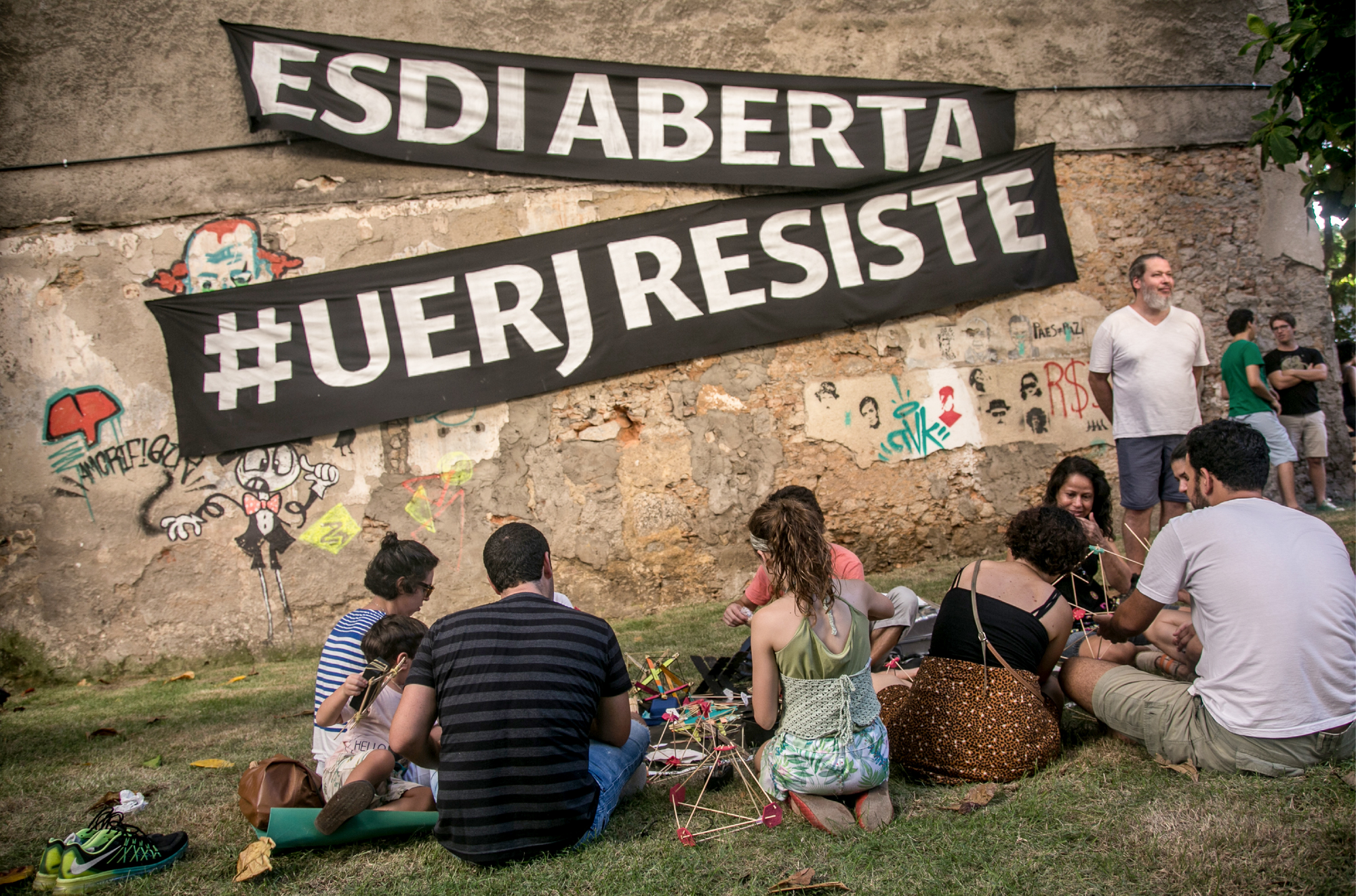
Zoy Anastassakis: Working in a public university, I see my role as a public servant. So I am asking myself, how can I—a white woman with a tenured position at the university—work together with other people that will teach me other things that I still don’t know? And how can I open spaces for thinking about that in the design school? ESDI, a historically elitist design school that was majority white and upper middle class, has had an influx of Black, Brown, and working-class students over the past 20 years—and, still, most teachers come from a white, middle-class background. We don’t know about the suffering of the students, or about their daily experiences facing the design education that we offer to them. So, as part of my commitment, I pay attention to the students and the difficulties they face, trying to create spaces for conversations and exchange.
At the same time, all of us have to think about our own fragilities. We must acknowledge these different conditions that we all experience as different subjects, and create space for the students to talk; spaces where all of us, including me and my colleagues, can share our own challenges and struggles. Sometimes, we can even cry together, or talk about private matters—in this way, we join forces to counteract privilege and fragility in the institution.
“We must acknowledge these different conditions that we all experience as different subjects, and create space for the students to talk; spaces where all of us, including me and my colleagues, can share our own challenges and struggles. ”—Zoy Anastassakis
Tanveer Ahmed: Zoy, what you are saying resonates with me. Like many people, I am inspired by the work of the feminist academic Sara Ahmed. In her book Living a Feminist Life, she talks about bringing together all these different aspects of your life—activism, pedagogy, and everyday life. For many years, I faced many problems as a design educator because of separating lots of things in my life. Bringing them all together helps you… it’s not just about recognizing privilege, but it’s what you do with that privilege as well. Now, I am engaged locally in community activism, working against racism. University space is exceptionally exclusive and privileged. It is a challenging balance.
However, I think it’s essential for us as educators to do work in the community to get out of the university. In terms of pedagogy, there are many community-based initiatives that design could learn from. In the UK, there were movements for supplementary schools. Black parents set up Saturday schools, seeing how formal education wasn’t representing their children and communities. So, there was the Black Education Movement, and also the Black Parents Movement, and they’ve been happening for many decades in this country. I myself was involved with similar community work around 15-20 years ago, when I taught fashion to children via a program called “Camden Summer University.” This program gave children from less privileged backgrounds the opportunity to engage in activities during the summer holidays when they would otherwise have had nothing else to do—and it was also free, which was a great help to their parents as well. Creating these programs helps to introduce that balance between recognizing privilege and engaging in pedagogy. This type of on-the-ground community work is crucial to help develop the spaces we wish to create.
Griselda Flesler: At the FADU, I direct the Gender Office. In this office we coordinate the application of Gender Violence Prevention Protocol of the University of Buenos Aires, regulating the institutional intervention in cases of sexual violence and gender-based discrimination. Sometimes we feel privileged because we have the power to run this space, and sometimes we feel useless because the institutions are challenging to manage. So, for example, the specific violence occurring inside universities is different from the gender violence that we know. Sexual assault and feminicidio (i.e. the hate crime of feminicide: the murder of a woman simply because of her gender identity), which is so widespread in society, seldomly happen at the university. Basing our reasoning only on this understanding of gender violence minimizes micro-machismos: the mansplaining, sexist jokes, and subtle behaviors more prevalent in academic spaces. We learned that the worst consequence of this systematically minimized violence leads to students dropping out. If we understand that, we begin to give it importance and adapt the protocols of violence and discrimination to this reality. So I feel privileged trying to help, even if I have poor tools to tackle the situation. It also creates an opportunity to develop these tools together.
I see my role as a channel to try sharing the power, which feels empowering; at the same time, I’m also in a position of power as the director of this office. The situation inside the classroom is similar. You might have the title because you are a professor or director, but you don’t have the power if you don’t share and build it with others, with the students. The key to building institutions is sharing power and, as Tanveer mentioned, always building bridges with the outside. But unfortunately, we often have this outside-inside situation at the university, receiving complaints about the violence students face in their households or workplace. As a result, we’ve organized some programs to work inside as well as outside the community, for example through the “Gender University Network”, which connects us with our colleagues at all national universities and enables us to rethink our institutions from a gender perspective.
“Sharing power sometimes means letting it go completely. [...] I think that’s something we can all learn from—to be led by students.”—Tanveer Ahmed
Tanveer Ahmed: Sharing power sometimes means letting it go completely. I used to teach these community Fashion and Textile classes in a space called Community Focus in North London. I came prepared with ideas of what I was going to do with students, but I could see that people weren’t listening. Suddenly, someone raised their hand and said, “Look, we just come to this fashion class to do our projects, and to have a cup of coffee with friends. You know, carry on getting paid, but just leave us alone.”
This was such an important lesson—to actually listen. I had to let go of all the ideas. I had to be led by the students, to do what they wanted to do. From a pedagogical perspective, I think that’s something we can all learn from—to be led by students. But obviously, in today’s marketized universities, the question is: to what extent can we achieve democratic forms of design education? Community spaces are much better equipped for this pedagogy.
Sria Chaterjee: So following this thread of thoughts, can the future of design education be designing a new structure to learn from? Do we have to get rid of the institution? Can we ditch the university?
Zoy Anastassakis: Between 2016 and 2017, during the two years of strong political and financial crisis at the Universidade do Estado do Rio de Janeiro, we had no conditions to resume classes, because staff and teachers were not receiving salaries, as ‘quota’ students were not receiving their grants. Still, we were fighting to keep the school open. Having so many institutional problems on our shoulders, we were trying to rebuild community and collective care in the design school, while experimenting with design education beyond the institutional constraints.
I still believe that design education can break those hard commitments of the universities from the inside. I think that design, as a field of knowledge, can create this openness inside those heavy institutions.
There are definitely many struggles at institutions. Even though we have the 40% quota for Black, Indigenous and working-class students, in our university very few actually come from native communities. Why don’t we attract Indigenous applicants? I started looking at some post-graduate programs that worked really hard to implement the affirmative policies, by creating specific application processes for Black students, and specific application processes for Indigenous people. One issue is language. For Indigenous communities, Portuguese is already their second language, after their native tongue. And we require an English Proficiency Test, because we think that to learn Design Theory, we need to read in English. So we’re expecting competence in their third language—for many, that barrier to entry is just too high. So, I think it’s important to keep looking for the next potential issue, and understand that we still have a lot of battles to fight.
“I think it’s important to keep looking for the next potential issue, and understand that we still have a lot of battles to fight.”—Zoy Anastassakis
Sria Chaterjee: How do you deal with and potentially change the conservative and reactionary teachers or staff members who often work against your values? How do you work together?
Tanveer Ahmed: I don’t know if I want to work together with everyone anymore. But, I think resistance is critical, too. Saying ‘no’ when it’s right is essential. Particularly for me, being a woman of color, saying no has become my toolkit, echoing Sara Ahmed. When I was 18, I attended Middlesex University in London, England. During my time there, there was a student occupation of the building that lasted for a couple of months. It had a significant impact on me as a teenager, and I often think about the kind of environment that we had there. We would sleep and eat in the college. There was alternative education happening—this has always been my dream. At the time, many of our teachers had been involved in the 1968 occupation at Hornsey School of Art in London. So there are small pockets of spaces where you can get inspiring, exciting, radical things happening. At the Royal College of Art, I have been involved in co-running with students a Womxn/Non-Binary People of Color Feminist reading group. It provides a space to question the dominance of Eurocentric heteronormative male-dominated views in art and design. Together, we share texts and visuals from a women-of-color feminist perspective to consider more inclusive forms of art and design practices and theories.
I don’t think we necessarily need to ditch universities, but we need to change the terms on which they operate. We need to change who’s teaching, how they’re teaching, and who even gets accepted into the university—both its students and its teachers. Hopefully, with a lot more educators and students exposing education inequalities, there will be more transparency and more people talking about it. Because indeed, when I was an undergraduate student and experienced racist incidents, there was no one to whom I could turn. Twenty years later, many different art schools in London still don’t have a clear complaint process. This has to change! And I think education is one space where we can challenge things.
Sria Chaterjee: Following on the pockets of hope that bring in community activism within the space of the university, I wondered if you have any concrete suggestions for alternative projects, or learning spaces that might be helpful to think about?
Tanveer Ahmed: In the UK, several projects deal with Britain’s violent colonial history. For example, Colonial Countryside looks into the past of celebrated, stately, wonderful country homes throughout the UK. The project team traced the origin of the finances behind these buildings, and found out that the construction of 97 of the UK’s stately homes was directly linked to income from the slave trade. They have also done amazing educational projects, exposing colonial stories. For example, they take school children to different stately homes and explain why Powys Castle in Wales has more objects from India than the National Museum in Delhi.
Another great example is Shades of Noir, at the University of the Arts London, which has been tirelessly centering social and racial justice in higher education for over 10 years. They look at art and design, education, foregrounding marginalized communities, and incorporating social justice on the organizational, educational and pedagogical level. They work with and employ students. They have these fantastic booklets, Terms of Reference, which tackle a broad scope of issues, including colorism, mental health and creative healing, women and non-binary identities, inclusive practices, and more.
Many decolonizing initiatives are happening at museums. Museum Detox, for example, is a network of POC working with the questions of representation in museums, galleries, libraries, and more. Dan Hick, an archeology scholar who specializes in the subject of the British Empire, has been campaigning for the return of the Benin bronzes stolen from Nigeria by Britain, which is currently on display in over 150 museums in the UK.
These are exactly the conversations we should be having in design: object-led learning. I’ve been trying to do so myself, looking critically at the origin of the resources I use as a fashion design educator. For example, I look at pattern cutting, to understand where it originated. We can do this exercise for every design discipline. Why are we even using pencils; where do they originate? What knowledge is constructed through them?
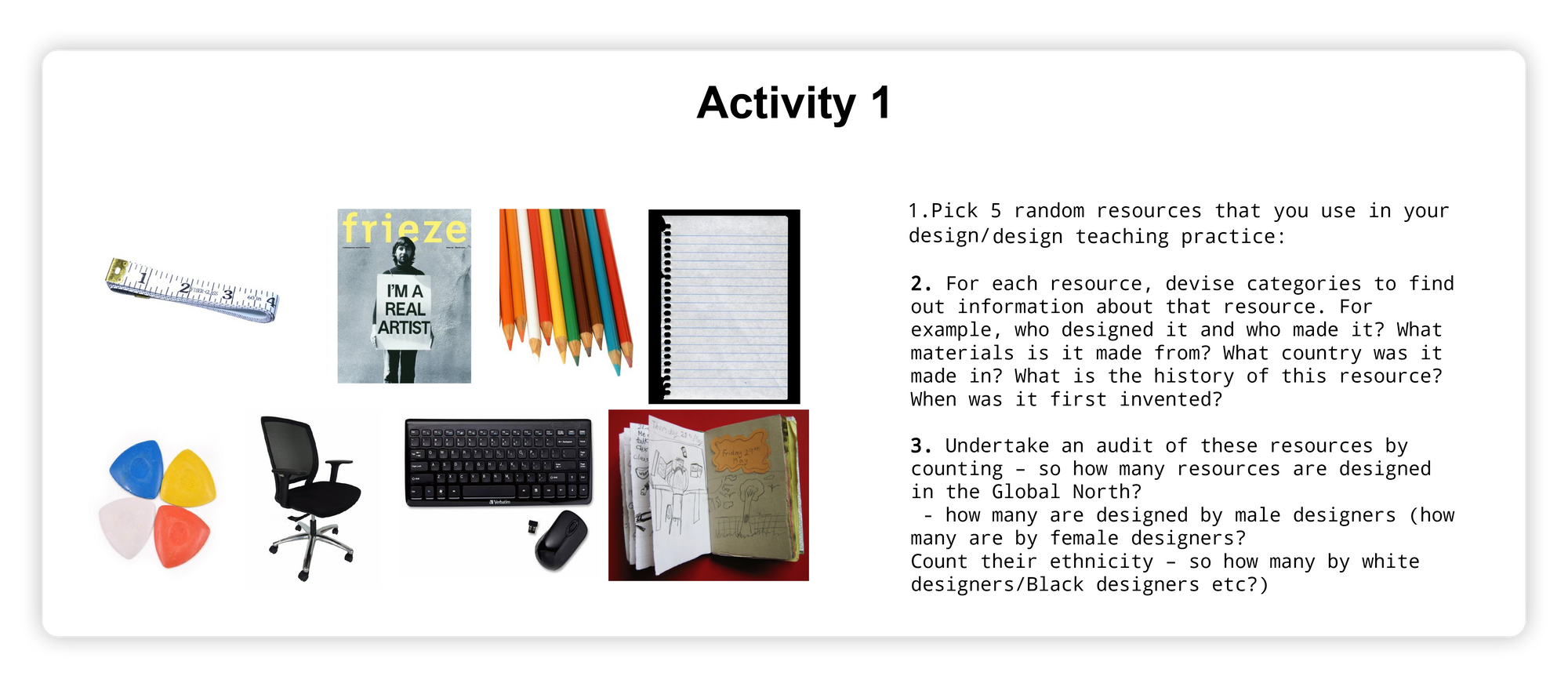
This text is derived from a rountable discussion organized by the Camden Art Center on July 21, 2021. The event, titled Antiracist Futures: Reclaiming Design Pedagogy, was inspired by the publication Design Struggles: Intersecting Histories, Pedagogies, and Perspectives, edited by Claudia Mareis and Nina Paim, and published by Valiz. The text was transcribed and edited for clarity and brevity.
Tanveer Ahmed (she/her) is a practice-led fashion design researcher and anti-racist educator exploring ways to expose and re-think how dominant Eurocentric racial hierarchies are used as part of the fashion design process. She is a Senior Lecturer in Fashion and Race at Central Saint Martins working across the fashion programme to support decolonial fashion perspectives. Her research emerges from experiences of teaching fashion design over the last twenty years and recognising the urgent need to explore alternative non-extractive, anti-racist and social justice-oriented forms of fashion design pedagogies. This approach emphasizes a more situated, relational and contextualized fashion design praxis by centring plural, non-heteropatriarchal, noncapitalist forms of fashion inspired by pre-colonial concepts of fashion that respect our planet and multi species.
Zoy Anastassakis (she/her) is a Brazilian Designer and Anthropologist. Between 2016 and 2018, she was Director at Escola Superior de Desenho Industrial, Universidade do Estado do Rio de Janeiro (ESDI/UERJ), where she works as an Associate Professor. At ESDI, she coordinates the Laboratório de Design e Antropologia. She is an associate researcher at the Center for Research in Anthropology (CRIA), Lisbon, Portugal. In 2020, she created the independent studies programme in “humusities”—a term suggested by Rusten Hogness and theorized by his partner Donna Haraway, meaning ecologically conscious humanities. Together with Marcos Martins, she is the co-author of Everyday Acts of Design: Learning in a Time of Emergency, a book on ESDI’s experimentations during the period of 2016-201, at Bloomsbury’s series “Design in Dark Times.”
Sria Chatarjee (she/her) is an art historian and environmental humanities scholar. She specializes in the political ecologies of art and design from the 19th century to the present, with a particular focus on transnational environmental histories, the histories of art and science, and the relationships between climate and race. Sria is currently Head of Research and Learning at the Paul Mellon Centre for Studies in British Art in London, England. Previously, she was a Researcher at the Institute for Experimental Design and Media, Fachhochschule Nordwestschweiz (FHNW) in Switzerland, and a post-doctoral fellow at the Max-Planck Kunsthistorisches Institut, Florence, Italy. Sria holds a PhD from Princeton University and founded the award-winning international digital project, Visualizing the Virus.
Griselda Flesler (she/her) is a graphic designer, Specialist in Design Theory and Master in Communication Design at the Faculty of Architecture, Design and Urbanism, Universidad de Buenos Aires (FADU-UBA), and a PhD student in the Faculty of Social Sciences at UBA. Her project studies queer uses of university space. She is the Head of the Gender Office and coordinates the application of Gender Violence Prevention Protocol at FADU-UBA (Unidad de Género). She is also a researcher and Associate Professor of Design and Gender Studies at FADU-UBA. This undergraduate course, of more than 400 students per year, proposes the integration of the main theoretical guidelines of gender studies for their incorporation in the design of interdisciplinary projects. This generates a critical reading about the field of design as a cultural practice while working on specific issues among students of Architecture, Industrial Design, Graphic Design and Fashion Design.
Read The Last Shift by Maya Ober for more on how feminist activism plays itself in the Chair of Gender and Design at FADU, Buenos Aires.


